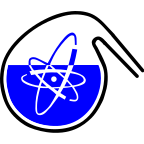Speaker
Description
Radionuclides, in particular actinides, can cause a serious health risk upon incorporation. Regarding the development of potential decontamination therapies, a detailed understanding of the different biochemical reactions of incorporated actinides is highly required. In the human body, actinides preferentially interact with blood serum components. One representative of utmost importance is human serum albumin (HSA), the most abundant protein in the human blood plasma. HSA binds and transports a range of predominantly water-insoluble molecules such as fatty acids, hormones and drugs as well as metal ions. Since albumin possesses four partially selective metal binding sites it can potentially also bind and thus transport incorporated actinides.
The complexation of Cm(III) with HSA is investigated in the pH range from 3.5 to 11.5 using time-resolved laser fluorescence spectroscopy (TRLFS). The Cm(III) HSA species displays an emission band at λ
The investigations regarding the identification of the Cm(III) HSA binding site were focused on the two binding sites with the highest affinities to metal ions. These are the N-terminal Cu and Ni binding site (NTS) and the multi metal binding site (MBS), which binds predominantly Cd and Zn. Competitive titrations of Cm(III) HSA with Cd(II), Zn(II), Cu(II) and Ni(II) point to complexation of Cm(III) at the NTS site. This is confirmed by NMR measurements with Eu(III) and Am(III). With increasing Eu(III) and Am(III) concentration the signal of proton H8 which is located on the His residue at the NTS decreases. Further TRLFS and NMR experiments were performed with recombinant human serum albumin (rHSA), an albumin variant with single deletion of Asp from the N-terminus. The results indicate an involvement of this Asp residue in Cm(III) binding confirming the NTS as the preferential Cm(III) binding site.
The results presented in this study focus on the identification, speciation and structural investigation of Cm(III) HSA. For the first time thermodynamic data were derived which allow a quantitative description of the complexation reaction. Under physiological conditions (pH 7.4, 37.5°C) about 90% of the Cm(III) is coordinated to albumin which indicates that complexation with HSA is a relevant biochemical reaction incorporated actinides might undergo enabling the transport of actinides in the human blood.
The research stay of M. Keskitalo at KIT-INE was financed by the EC GENTLE project.

